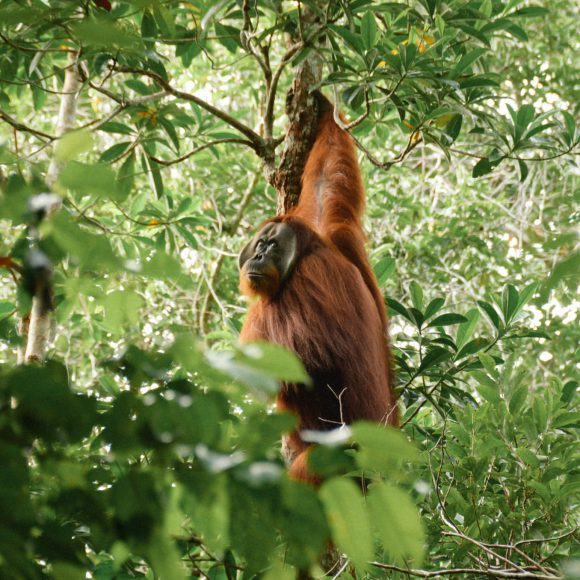Discovering Suaq and it’s unique orangutans
The Suaq monitoring station was founded in 1994 when Professor Dr. Carel van Schaik was looking for a research site to study the behavior of the Sumatran Orangutans. Right at its discovery, Carel realized that the orangutans in this peat swamp forest are different than orangutans at other sites. First of all, the orangutans at Suaq occurred at a higher density and showed a uniquely high level of social tolerance. Second, the Suaq orangutans were found to habitually use tools, a behavior that very few non-human species show in the wild.

The old Suaq camp was built in 1993 and for 6 years accommodated researchers from all over the world. Photo credit: C. van Schaik 1994.

In 1994, Carel van Schaik (sitting in the middle of the bottom row) brought the first research team to Suaq. Among others his former PhD student Ian Singleton (on the left in the middle row) who is the current director of the SOCP. Photo credit: C. van Schaik 1994.

In 2007 research activities at Suaq have been resumed. Since then, numerous students and researches from various countries have conducted their studies on this unique orangutan population. Photo credit: Staff and students of the Suaq program 2017.

The Suaq monitoring station was rebuilt in 2007, several kilometers south of the old camp. Photo credit: U. Wipfli, 2017.

The Suaq orangutans are the only orangutan population that uses tools flexibly and on a regular base. Here, Xavier is using a tool to get sweat bees out of a tree hole. Photo credit: Mudin, May 2013.

Orangutans use umbrellas made of leaves to protect themselves from the rain or sun. Here, 3 year old Lois is trying to make one of his first own umbrellas. Photo credit: C. Schuppli, March 2014.

At Suaq, even unrelated adult males tolerate each other close by. Here Gura is watching Saudade feeding from very close. Photo credit: J. Kunz, February 2017.

Due to the high food availability, unlike at other places orangutans at Suaq can get quite chobby like Ellie here as a juvenile. Photo credit: C. Schuppli, February 2011.
Suaq raised to one of the most renowned orangutan research sites
With the aim to understand the biology and behavior of this unique orangutan population, behavioral research was started in 1994. A monitoring station was established at the shore of the Lembang River in the heart of the rainforest, providing accommodation to researchers and local staff members. A wooden boardwalk made it possible to access the more remote areas of the deep peat swamp forest.
Soon, the uniqueness of Suaq orangutans, especially the complexity of their behavior, attracted researchers from all over the world. After a disruption from 1999-2007, due to the civil war in Aceh, the monitoring station was rebuilt several hundred meters down river of the previous station.
Carel and his team resumed research activities, now under the Department of Anthropology of the University of Zürich (AIM) in collaboration with Universitas Nasional Jakarta (UNAS) and under the administrative management of the Sumatran Orangutan Conservation Program (SOCP).
The long-term research effort is paying off
Over the last 20 years, behavioral data on more than 100 individually recognized Sumatran orangutans was collected at Suaq, resulting in more than 10’000 observation hours. This data has produced a variety of highly relevant findings for conservation such as the first wild life history data on longevity, reproductive rates, mortality as well as home range use and other ecological needs of the Sumatran orangutan. Also, the behavioral data has provided unique insight in cultural and cognitive evolution.

From being born to giving birth: Thanks to the long research effort, we could register 15.6 years, the age at which Ellie gave birth to her first baby Eden as one of the first confirmed ages at first reproduction for wild Sumatran Orangutans. Eric Balke, January 2015.

The new boss: After being seen in the research area again and again for over 20 years, Dian has now turned into a strong canditate for the postion of the locally dominant flanged male. Photo credit: Caroline Schuppli, February 2017.

From unflanged to flanged: Balu is one of the males which we have observed transforming from a small unflanged into a strong flanged male. Photo credit: Eric Balke, December 2014.

Old mother: With 6 confirmed offspring, Friska is one of the oldest females at Suaq. DNA analyses helped us to reconstruct her impressive family tree. Photo credit: E. Balke, 2015.